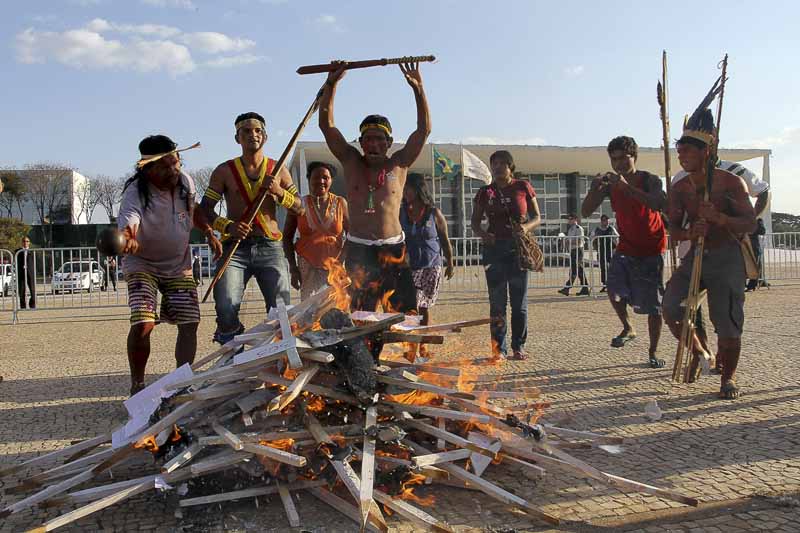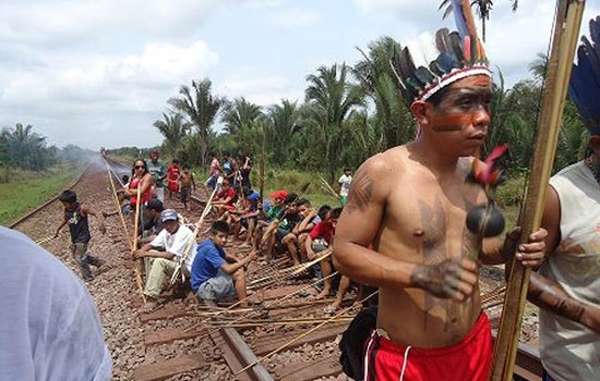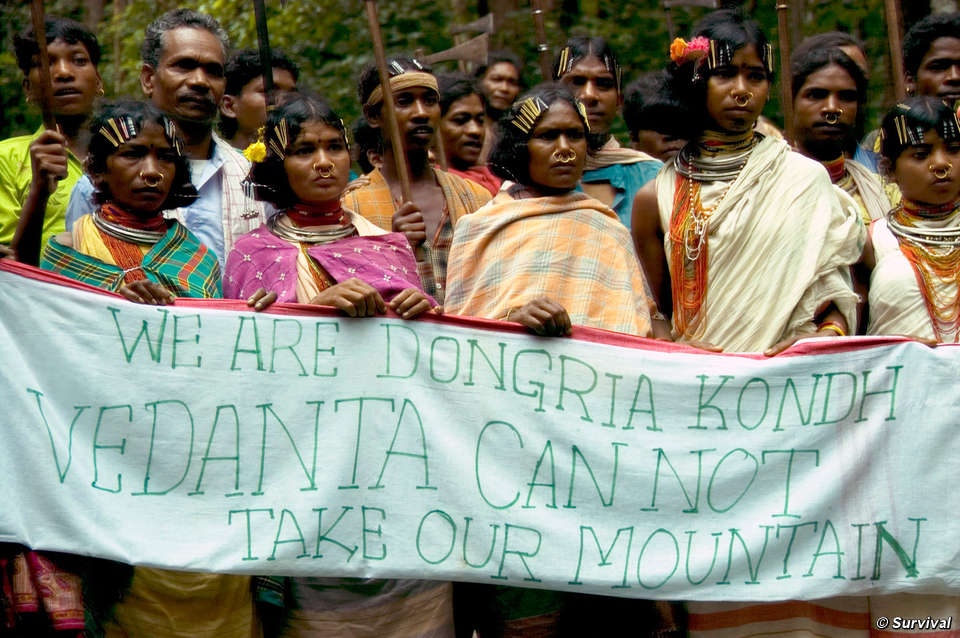
by Deep Green Resistance News Service | Oct 9, 2012 | Biodiversity & Habitat Destruction, Colonialism & Conquest, Indigenous Autonomy, Obstruction & Occupation
By Jeremy Hance / Mongabay
Construction on Brazil’s megadam, Belo Monte, has been halted again as around 150 demonstrators, most of them from nearby indigenous tribes, have occupied the main construction site at Pimental. Over a hundred indigenous people joined local fishermen who had been protesting the dam for 24 days straight. Indigenous people and local fishermen say the dam will devastate the Xingu River, upending their way of life.
“The renewed occupation of the project’s earthen cofferdams paralyzed construction works, while indigenous protestors seized the keys of trucks and tractors forcing workers to leave the strategic Pimental work camp on foot,” reads a press release from the NGO Amazon Watch. Around 900 workers were sent home.
This is the second occupation attempt in less than six months. Over the summer some 300 indigenous people sustained an occupation of the dam for 21 days, before breaking it off though little headway was made in talks with consortium building the dam, Norte Energia.
The Belo Monte dam, which would be the world’s third largest, has been plagued by controversy from its origin decades ago; the battle for the dam has been fought both in Brazil’s courts and on the international stage. If built, the dam will flood an estimated 40,000 hectares of present rainforest and could push some fish species to extinction. In addition, 16,000 people will be displaced according to the government, though some NGOs say the number is more likely double that.
Despite the impacts, the dam has been strongly supported by Brazilian President Dilma Rousseff, and every legal injunction against the dam has been overturned. Norte Energia has filed with a local court for repossession of the construction sties.
Indigenous groups say the construction of the dam is already imperiling their way of life, as the Xingu river becomes more difficult to navigate. They have also said they have no intention of leaving until Norte Energia meets their demands.
“We are witnessing the devastation of this land. The island of Pimental was completely destroyed, with a sole tree left standing, and the water is putrid. It is very shocking,” an protestor told Amazon Watch.
Dams are often described as ‘green’ energy source, however in the tropics they actually release significant methane emissions due to rotting vegetation. Although it has a shorter life than carbon, methane is a far more potent greenhouse gas.
From Mongabay: “Indigenous groups re-occupy Belo Monte dam in the Amazon“

by Deep Green Resistance News Service | Oct 6, 2012 | Colonialism & Conquest, Indigenous Autonomy, Mining & Drilling, Obstruction & Occupation
By Survival International
A protest involving Earth’s most threatened tribe, the Awá, has forced the world’s largest iron ore mine to suspend operations along its main railway line.
On Tuesday, hundreds of Indians including the Awá, took to the tracks of Vale’s Carajás railway to voice their opposition to Brazilian government plans that could weaken their land rights, if legalized.
The demonstration follows months of anger surrounding a draft text called Directive 303, which prohibits the expansion of indigenous territories.
The government has refused to scrap the proposed directive, despite it violating national and international laws by suggesting certain projects can be carried out on Indian land without proper consultation.
Frustrations spilled over on Tuesday, with several different tribes uniting to demand that their land rights are respected.
The blockade is the latest in a string of controversies to involve mining giant Vale, whose railway borders the territory of the Awá.
Last month, a judge reversed a ruling that had stopped the company from doubling its railway line to increase production.
The decision was a blow for the Awá, who blame the railway for bringing thousands of invaders into their lands and scaring off the animals they hunt.
Survival’s Director Stephen Corry said today, ‘If Brazil wants to lead the way and show the world that it respects its indigenous peoples, it should not be entertaining the harmful propositions of a handful of rural lobbyists. This protest shows that for tribes like the Awá, land rights are make or break.’
From Survival International: http://www.survivalinternational.org/news/8722
by Deep Green Resistance News Service | Oct 5, 2012 | Colonialism & Conquest, Indigenous Autonomy, Obstruction & Occupation
By Moises Castillo and Romina Ruiz-Goiriena / Associated Press
Thousands of indigenous Guatemalans shouted in anger Friday and some threw themselves at the coffins of six local people who were shot to death during a protest over electricity prices and educational reform in a poor rural area.
A seventh victim died later at a hospital in the western city of Quezaltenango.
President Otto Perez Molina acknowledged that government forces had opened fire during the protest Thursday, after saying earlier that police and troops on the scene had been unarmed and the protesters had provoked the clash.
Human rights groups condemned the government’s actions and charged they were part of a pattern of excessive use of force against protesters.
The protesters were blockading a highway near the town of Totonicapan, about 90 miles west of Guatemala City, when two vehicles carrying soldiers arrived to help police who had been ordered to evict the demonstrators. Gunfire erupted after the troops came. Bullets killed seven people and wounded 34, officials said.
“We were protesting right next to them when they opened fire on us,” said Rolando Carrillo, a 25-year-old protester with a bandaged arm and lacerated face that he said resulted from being hit during the clash.
The president told reporters Friday afternoon that armed security guards had driven the soldiers to the protest. One of the guards apparently was the first to start shooting and then an unspecified number of others fired at the crowd, Molina said.
He said seven soldiers injured in the confrontation had said they only fired into the air to protect themselves from what they considered to be a threatening crowd.
Interior Minister Mauricio Lopez Bonilla said the president had suspended the order to evict the protesters from the highway.
Some 20 human rights organizations called an emergency meeting in the capital to discuss the incident and called for a protest in front of the presidential palace.
“We’ve been saying for a long time that the army’s use of force brings with it the risk that something like this could happen,” said Francisco Soto, a representative of the Center for Legal Action and Human Rights.
Six of the dead were buried Friday afternoon in Totonicapan, where thousands gathered to watch their coffins pass through the town’s central square. Hundreds shouted “Justice! Justice!” while dozens of mourners hurled themselves toward the coffins in grief.
Read more from The Washington Post:

by Deep Green Resistance News Service | Oct 2, 2012 | Indigenous Autonomy, Mining & Drilling
By Patricia Ardón and Orfe Castillo
“In the struggle to defend our territory, our natural resources, what’s at stake is our very existence.” – Miriam Pixtún, Indigenous Women’s Movement Tz ́ununijá
In Guatemala, the policy of enclaves and extraction of natural resources fomented by the current development model and by the transnational corporations has a tremendous impact on the life of the communities, particularly on indigenous peoples and women.
With the aim of sharing experiences and analysis among women who lead organizing in defense of rights to land, territory and natural resources in Guatemala, Sinergia No ́j, T ́zununijá, Just Associates (JASS), Uk ́Ux B ́e, Unit of Guatemalan Human Rights Defenders (UDEFEGUA), Association for Feminist Studies (AMEF) and the National Union of Guatemalan Women (UNAMG) held the national meeting “Women in Defense of of Water, Life and Territory” on Sept. 11-12, 2012. More than forty women from different parts of the country participated in the meeting.
“We resist due to the disadvantages of the megaprojects; the development that the companies offer just leaves more poverty, sickness, deaths–all kinds of problems. They use pesticides, strong chemical products. They pollute the water… our house are cracked, animals have died, now the corn doesn’t grow, it’s dried up. Water is scarce and polluted. What kind of development is this?” said one participant.
According to Carmen Lucía Pellecer, Co-Directora of Sinergia Noj, the forum enabled indigenous women to talk about experiences of resistance, the acts they carry out in their communities and in their daily lives.
Another participant pointed out, “The megaprojects represent a clash with our vision of the world, the natural resources are interconnected elements of life, we are part of it. What the capitalist companies do has consequences for our way of living together, they use impoverishment to manipulate people, they affect our health, they cause illnesses of the skin, of eyesight. The hydroelectric plants block the flow of the rivers, they cause droughts. We have been exposed to high tension wires, the looting of our lands… All the community has united to stop it but at the cost of being criminalized. They attack us for not giving in, they threaten us with prison, they don’t respect the consultation processes that are binding. For women, all this implies a heavier workload, persecution, facing militarization that revives the horrors of the war–we see soldiers and it generates terror because we know what happened to our mothers, our aunts.”
The gathering also served to present the report of the Nobel Women’s Initiative/JASS delegation, led by Nobel Laureates Jody Williams and Rigoberta Menchú. The delegation visited Guatemala, Honduras and Mexico in January of this year to examine violence against women; most of the women present at the September gathering presented testimony to the delegation in January. Many participants noted that the report helped build a regional view of the situation and of women’s struggles. These links give women a stronger voice and more political influence, they asserted.
Miriam Plxtún of the Movement of Indigeous Women Tz ́ununija identified several major achievements of the gathering, including the importance of creating their own space for recognizing and strengthening the peaceful struggle in defense of territory and natural resources, the discussion of alternatives, and the effort to build cross-border alliances that spread information on the effects of mega-projects. She also stated that the group made specific commitments to continue the analysis on key issues.
The organizations that called the event agreed on the importance of strengthening access to timely, specialized and accurate information on the impact of megaprojects on societies and on women, and of broadening networks and alliances from the local to the international level, drawing in all actors who can contribute to prevent the death and looting of the peoples.
Finally, at the gathering several women described the work being done by the Mesoamerican Women Human Rights Defenders Initiative and the National Network of Women Human Rights Defenders of Guatemala. These organizing efforts, they said, have increased recognition of women’s struggles and awareness of the security challenges for women human rights defenders.
Pixtún recalled that in Guatemala, indigenous women have a long way to go to recuperate the fundamental meaning of democracy, which is the power of the people. Women contribute in an essential way to the construction of dignified lives, she told the group, and it’s time for others–men and women–to join in this effort from all over. Indigenous peoples and women have the right to live according to their own cosmovision, to be recognized as full rightsholders and as important political actors.
From Americas Program: http://www.cipamericas.org/archives/7992
by Deep Green Resistance News Service | Oct 1, 2012 | Colonialism & Conquest, Indigenous Autonomy, Obstruction & Occupation
By Mongabay
200 indigenous men and women are blockading shipments of construction materials to a dam site in Malaysian Borneo to protest the impact of the hydroelectric project on their traditional forest home, reports the Bruno Manser Fund (BMF), a Switzerland-based group that campaigns on behalf of forest people of Sarawak.
According to the NGO, on the morning of September 26, 200 Penan and Kenyah set up a blockade on the road used by trucks to deliver supplies to Murum dam, a controversial project being built by China’s Three Gorges Corporation. The protesters say they will maintain the road block until Sarawak Energy, the agency behind the dam, meets with them and agrees to their demands relating to involuntary resettlement and their traditional land rights. The dam would flood up to 250 square kilometers of rainforest and farmland, affecting some 1,400 people, says BMF, which adds that the communities fear a repeat of the nearby Bakun dam.
“They have witnessed how the quality of life decreased for their neighboring communities affected by Bakun dam, one of the biggest dams in Asia, when they were forcefully displaced in 1998,” BMF said in a statement. “They do not want to face the same fate: loss of livelihood, poverty and loss of culture.”
The government of Sarawak is planning to build at least a dozen dams over the next twenty years, well exceeding the state’s demand for electricity. But Sarawak says it aims to attract energy-intensive industries like mining. Critics argue that the primary motivation is corruption: large infrastructure offer big opportunities for officials to line their pockets using state funds. Sarawak’s Chief Minister Abdul Taib Mahmud is accused of amassing a personal fortune of some $15 billion through such approaches as well as control over the state’s forest resources.

by Deep Green Resistance News Service | Sep 18, 2012 | Colonialism & Conquest, Indigenous Autonomy, Lobbying, Mining & Drilling
By Survival International
Supporters of India’s Dongria Kondh tribe are celebrating after controversial British mining company Vedanta Resources declared it will close its bauxite refinery in the state of Orissa, this December.
The news is a major breakthrough for the tribe, who have fought a David and Goliath battle against Vedanta’s plans to extract bauxite from their land.
Dongria leader, Lodu Sikaka, said today, ‘We will be happy if the company leaves. If the refinery is there, they will keep trying to take our mountain, if not today, then tomorrow, or two years, 10 years from now.’
The Lanjigarh refinery sits at the base of the Dongria Kondh’s Niyamgiri Hills, which are home to the 8,000-strong tribe, and the seat of their god Niyam Raja. The company has spent more than one billion US dollars expanding the site without securing all the required clearances, as well as knowing it was unable to source enough bauxite to run the refinery at capacity.
Vedanta has now blamed the closure on a ‘depleting stock position of bauxite’. But, there are concerns the company’s announcement is intended to pressure the government into allowing it to mine the Niyamgiri Hills. The issue has returned to India’s Supreme Court, but the case is currently adjourned.
Opposition to Vedanta’s push to mine the mountains has embroiled the company in a near decade-long dispute, and forced the Lanjigarh refinery to be run with bauxite from different mines across India. A Vedanta spokesman claimed this has cost the company half a billion dollars.
Survival International’s Director Stephen Corry said today, ‘When we started our campaign for the Dongria Kondh, we were repeatedly told it was a hopeless case and the mine would be built. It hasn’t been. The infrastructure is rusting away and now Vedanta says it will shelve its refinery. This is a fantastic vindication of the tribal people’s determination to keep the lands which are rightfully theirs, and the pressure brought to bear by thousands of their and our supporters around the world. Public pressure is the only thing which can save tribal peoples in the long-term, and it works.’
From Survival International: http://www.survivalinternational.org/news/8670




